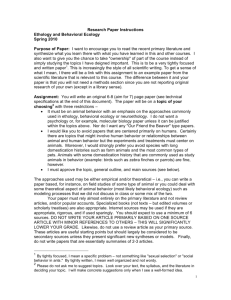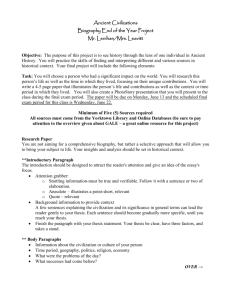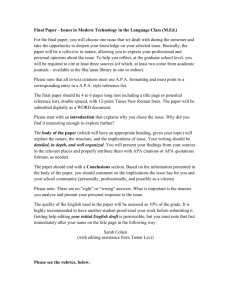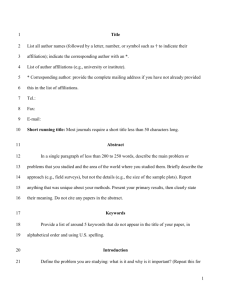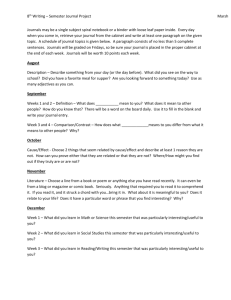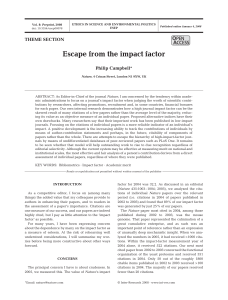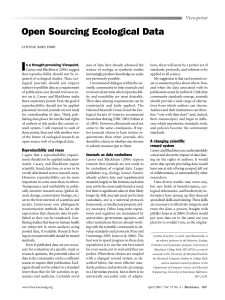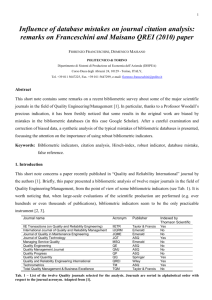Biology 160: The Written Report - University of San Diego Home
advertisement
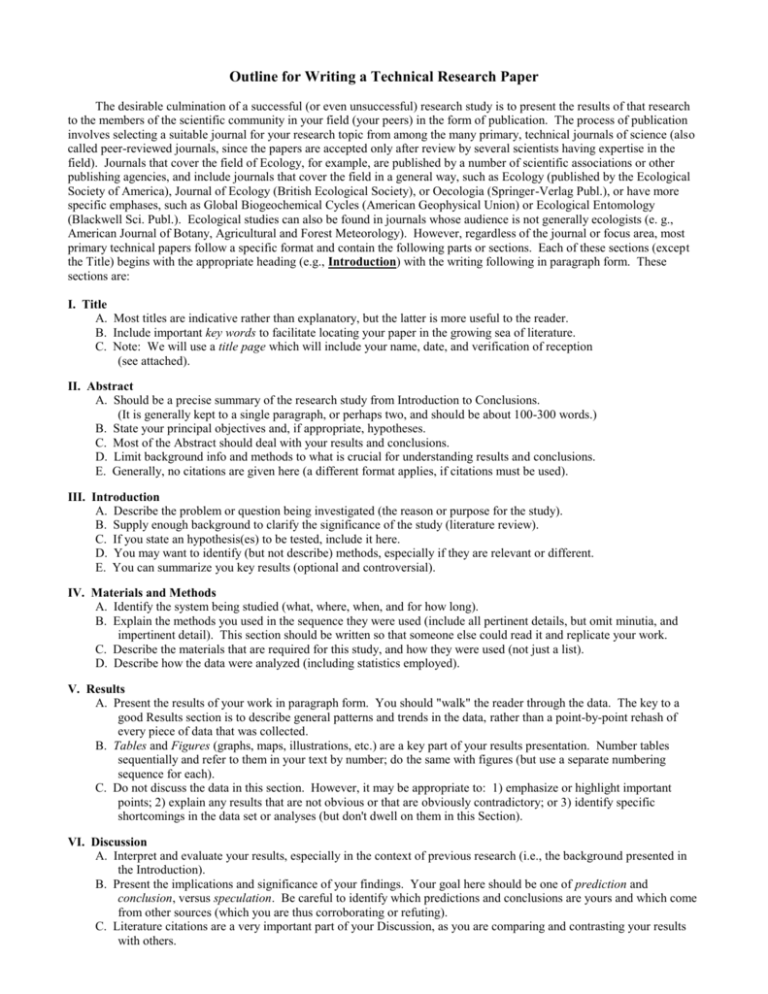
Outline for Writing a Technical Research Paper The desirable culmination of a successful (or even unsuccessful) research study is to present the results of that research to the members of the scientific community in your field (your peers) in the form of publication. The process of publication involves selecting a suitable journal for your research topic from among the many primary, technical journals of science (also called peer-reviewed journals, since the papers are accepted only after review by several scientists having expertise in the field). Journals that cover the field of Ecology, for example, are published by a number of scientific associations or other publishing agencies, and include journals that cover the field in a general way, such as Ecology (published by the Ecological Society of America), Journal of Ecology (British Ecological Society), or Oecologia (Springer-Verlag Publ.), or have more specific emphases, such as Global Biogeochemical Cycles (American Geophysical Union) or Ecological Entomology (Blackwell Sci. Publ.). Ecological studies can also be found in journals whose audience is not generally ecologists (e. g., American Journal of Botany, Agricultural and Forest Meteorology). However, regardless of the journal or focus area, most primary technical papers follow a specific format and contain the following parts or sections. Each of these sections (except the Title) begins with the appropriate heading (e.g., Introduction) with the writing following in paragraph form. These sections are: I. Title A. Most titles are indicative rather than explanatory, but the latter is more useful to the reader. B. Include important key words to facilitate locating your paper in the growing sea of literature. C. Note: We will use a title page which will include your name, date, and verification of reception (see attached). II. Abstract A. Should be a precise summary of the research study from Introduction to Conclusions. (It is generally kept to a single paragraph, or perhaps two, and should be about 100-300 words.) B. State your principal objectives and, if appropriate, hypotheses. C. Most of the Abstract should deal with your results and conclusions. D. Limit background info and methods to what is crucial for understanding results and conclusions. E. Generally, no citations are given here (a different format applies, if citations must be used). III. Introduction A. Describe the problem or question being investigated (the reason or purpose for the study). B. Supply enough background to clarify the significance of the study (literature review). C. If you state an hypothesis(es) to be tested, include it here. D. You may want to identify (but not describe) methods, especially if they are relevant or different. E. You can summarize you key results (optional and controversial). IV. Materials and Methods A. Identify the system being studied (what, where, when, and for how long). B. Explain the methods you used in the sequence they were used (include all pertinent details, but omit minutia, and impertinent detail). This section should be written so that someone else could read it and replicate your work. C. Describe the materials that are required for this study, and how they were used (not just a list). D. Describe how the data were analyzed (including statistics employed). V. Results A. Present the results of your work in paragraph form. You should "walk" the reader through the data. The key to a good Results section is to describe general patterns and trends in the data, rather than a point-by-point rehash of every piece of data that was collected. B. Tables and Figures (graphs, maps, illustrations, etc.) are a key part of your results presentation. Number tables sequentially and refer to them in your text by number; do the same with figures (but use a separate numbering sequence for each). C. Do not discuss the data in this section. However, it may be appropriate to: 1) emphasize or highlight important points; 2) explain any results that are not obvious or that are obviously contradictory; or 3) identify specific shortcomings in the data set or analyses (but don't dwell on them in this Section). VI. Discussion A. Interpret and evaluate your results, especially in the context of previous research (i.e., the background presented in the Introduction). B. Present the implications and significance of your findings. Your goal here should be one of prediction and conclusion, versus speculation. Be careful to identify which predictions and conclusions are yours and which come from other sources (which you are thus corroborating or refuting). C. Literature citations are a very important part of your Discussion, as you are comparing and contrasting your results with others. D. In this section you should identify limitations of your study, and recommendations for further research or for ways in which the research may be applied or extended. VII. Conclusions A. This can either be a short separate section, so headed, or may be the last paragraph of the Discussion, sans heading. B. Leave the reader with key take-home points of the study (generally, do not list the deficiencies of the study here). VIII. References A. This is the bibliography of other studies that you have specifically cited in your paper (hence it is sometimes called Literature Cited). B. There are numerous ways in which references are formatted in the Reference section (as well as some variation in the way references are cited within the body of the text). We will use the format used by the Ecological Society of America in its journals. Your references may include journal articles, books, book chapters, and numerous kinds of special publications and all have a certain specific format. The easiest way to determine the correct formatting is to observe the reference placements and formatting in a recent issue of the journal Ecology. Some useful hints for writing a scientific paper: 1. Organize your paper before you begin writing. Construct an outline that conveys what you want to accomplish with the paper. 2. It is often easier to write your paper in an order different from that of the final format. (For example, to get your feet wet, you may begin with the Methods and Materials section; then after you have good drafts of Figures and Tables, you can write the Results section. You may end up writing the Introduction last (or at least polishing it up last, since a good Intro is very important). 3. You may use either active or passive voice, first person or third person, but strive for consistency within paragraphs. Use correct and consistent grammar throughout the text. 4. Abbreviations for words other than units should be avoided, unless they symbolize some basic concept and are generally accepted (i.e., you see them used in journals or your texts). Examples are: BMR (basal metabolic rate) and NPP (net primary production). Such abbreviations should always be defined the first time they are used. 5. Abbreviations for units (g, ml, km, etc.) are not followed by periods unless they end a sentence. When reporting anything that has already happened, use past tense. Always include correct units in tables and figures 6. Never begin a sentence with a symbol or a numeral. If you must start a sentence with a number, it should be spelled out. 7. Except for the rule above, measurements are written as Arabic numerals when they exceed ten and spelled out if ten or less. Examples: "ten drops were added;" "there were three people in our group;" "we used 15 plants." 8. Do not report numbers to a level of precision not supported by the measurement technique (e.g., 16.9 °C or 17 °C vs. 16.8734 °C; this is esp. a problem when averaging data). Decimal fractions of numbers less than one should always have a zero to the left of the decimal (e.g., 0.94 not .94). If you report means ± std. error use the same number of decimal places for each. 9. All equations (and chemical reactions) should be numbered in a single sequence. The numbers should be in parentheses at the right end of the line containing the equation. These equations can then be referred to by their numbers in the text. For example, “…equation (3) shows...” 10. "Data" is a plural form (singular, datum); "Species" is both the singular and plural form of the word. 11. Scientific names include a genus and species. The former should be capitalized, but not the latter; both words should be italicized. *12. Plagiarism in any form, even unintentional, is a serious violation of Academic Integrity. Information acquired from other sources must always be properly referenced. Never include anything (data, statements, ideas!) in your paper that is not your own or is not correctly and completely referenced. Citing from a source does not mean that you can use the material verbatim (if you use a sentence verbatim, it should be set off with quotation marks, and properly cited). You should cite the source every time you use that material, not just the first time, and you should make it clear what material is taken from where (i.e., do not collect a group of references at the end of a paragraph, where it will be impossible to determine what material belongs to what source). Do not use footnotes; proper reference citation will be explained in class. TITLE Name Biology 460W Section # (Lab Instructor) Date Received By: Date (Signature) Evaluation Sheet - Paper #1 Primary Productivity of Algae Title: /3 Explanatory title with appropriate key words in the title /7 Precise summary of study from Introduction to Conclusions. /7 Concise, Focused (Background information for the experimental question– relationship between marine productivity & iron; include citations!) /3 Hypothesis or statement of question(s) to be investigated /4 Setup; Growth & pretreatment conditions /3 Measurements & techniques (+ citations) /3 Calculations and relevance /5 Description of findings and "walk-through" of graphs and tables Explanation of key findings and results of statistical tests Abstract: Introduction: Methods: Results: /5 Values (correct calculations of means, variances (SE), & other statistics) Tables (syntheses of raw data into easy-to-interpret values – including parameters for all cultures [Fe trtmnt] & each species) /5 Graphs (correct plots and axes; caption and axes labels; presentation) /10 Evaluation of Results and Comparisons to literature /5 Resolution of problems, discrepancies /5 Conclusions (a return to the original questions, hypotheses) /5 Use of reference citations in text, with correct formatting /5 Inclusion of References Section, which is correctly formatted /20 Logical development of ideas / Clear, concise sentences (grammar, spelling) / Presentation and layout /5 Discussion: References: Writing Style:
